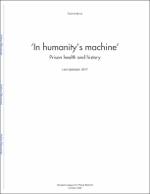‘In humanity’s machine’
Prison health and history
Author(s)
Byrne, Fiachra
Collection
WellcomeLanguage
EnglishAbstract
The pernicious and damaging effects of incarcerating juveniles has long been a topic of concern and controversy for reform groups, policy makers, childcare practitioners and academics; such concerns are doubly compounded where the mental health needs of the confined young person are in question. Yet, while there is a considerable scholarly literature on the history of juvenile delinquency and juvenile justice systems more broadly, there have been few substantial treatments of the institutional detention of juveniles in the modern era outside of official and non-official inquiries into historical allegations of child abuse. Equally, aside from a small number of highly focused studies, there is a paucity of scholarly research on the history of the mental health of juveniles in secure settings. Here, I detail the change in our understanding of the juvenile offender from that of a degraded if redeemable moral agent in the nineteenth century to our current conception of the detained youth as a figure marked by psychiatric morbidity, behavioural disturbance and complex needs. One of my central findings is that the context of institutional confinement itself has been an essential factor in the long-term psychiatric pathologisation of detained juveniles. This framed the scale, manner and context of their frequent group conceptualisation as potentially dangerous and uniquely debilitated by psychiatric morbidity. This is not to argue that the presence of trauma and psychiatric morbidity amongst juveniles in custody is simply a historical construct. Nor is it an argument that the use of psychiatry for detained youths merely constituted yet another instance of factitious medical labeling for the purposes of social control. Rather I suggest that, historically at least, the deployment of psychiatric diagnoses and treatment facilities within the youth secure estate has often primarily served institutional or political needs rather than the needs of juveniles in custody.
Keywords
prison; health; history; juvenilesISBN
xxxxxxxxxxxxxPublisher
Howard League for Penal ReformPublication date and place
London, 2017Grantor
Classification
Penology and punishment


 Download
Download